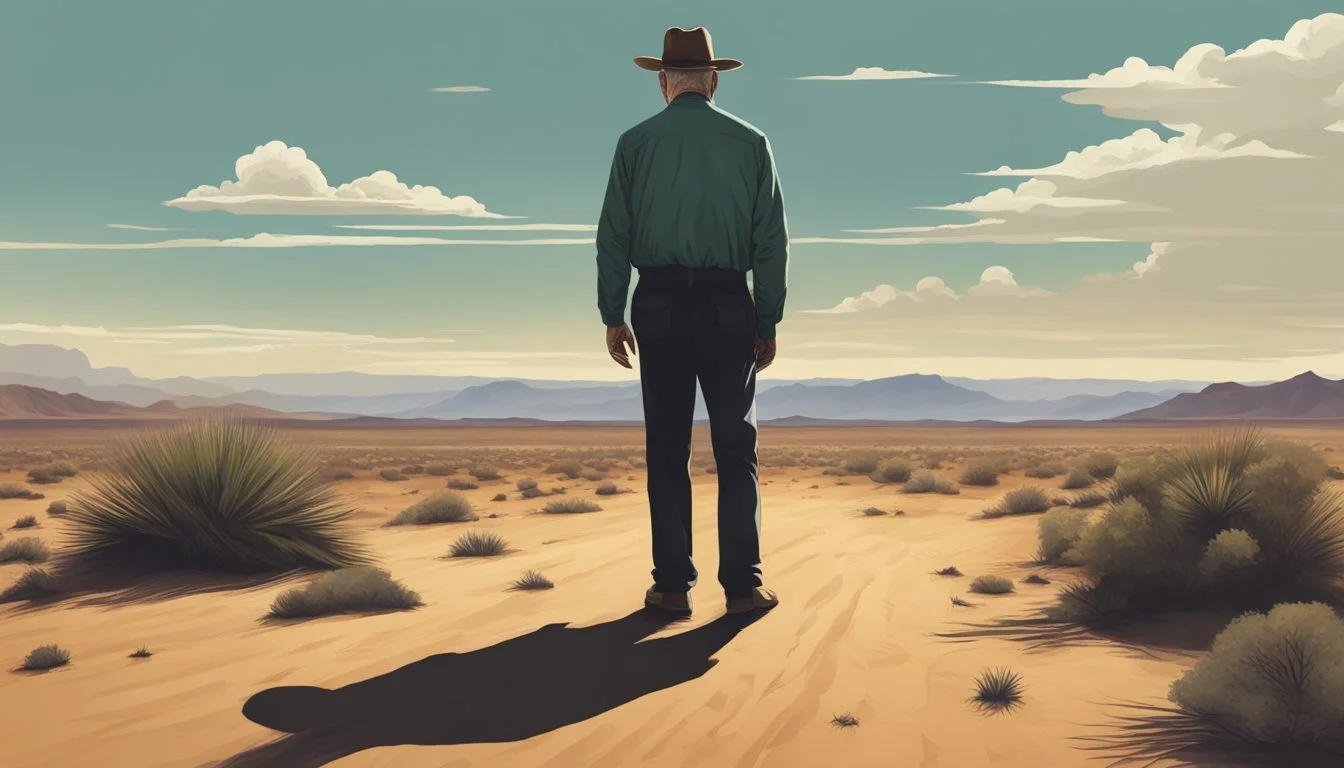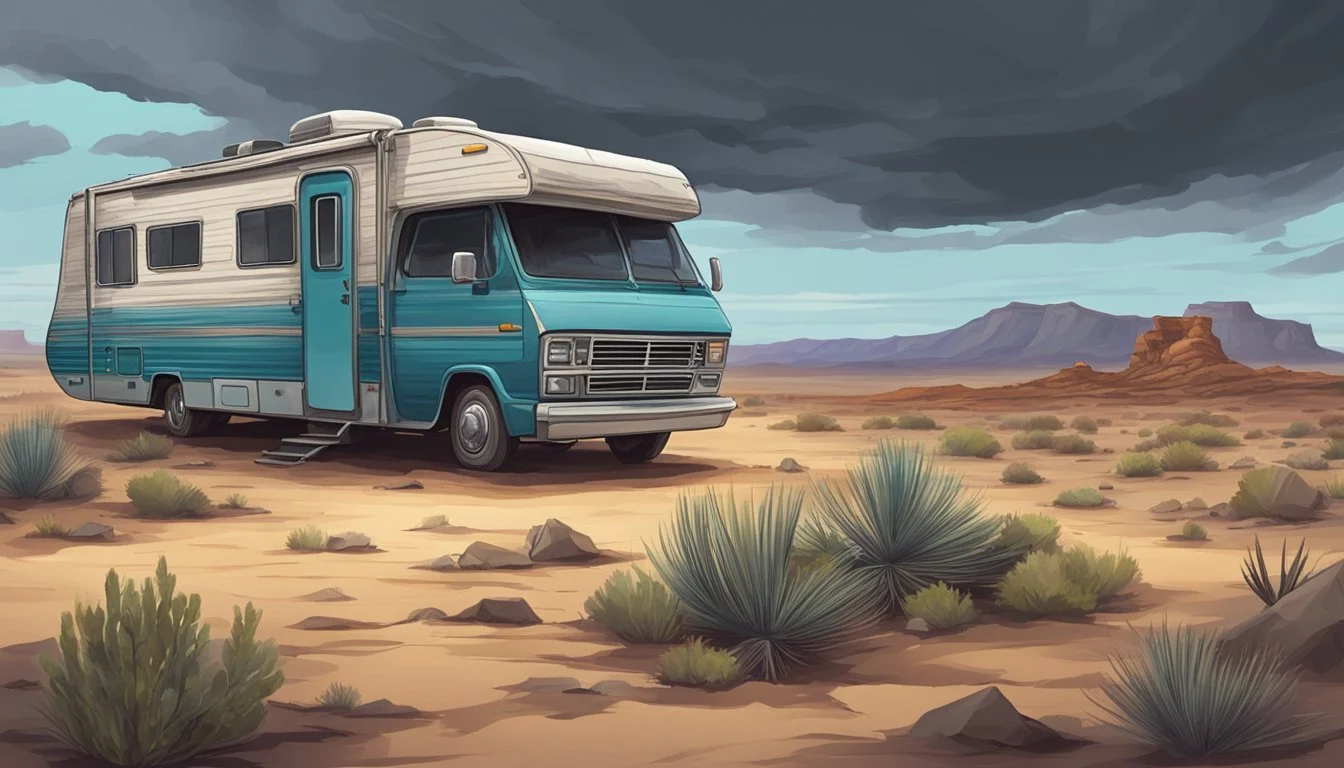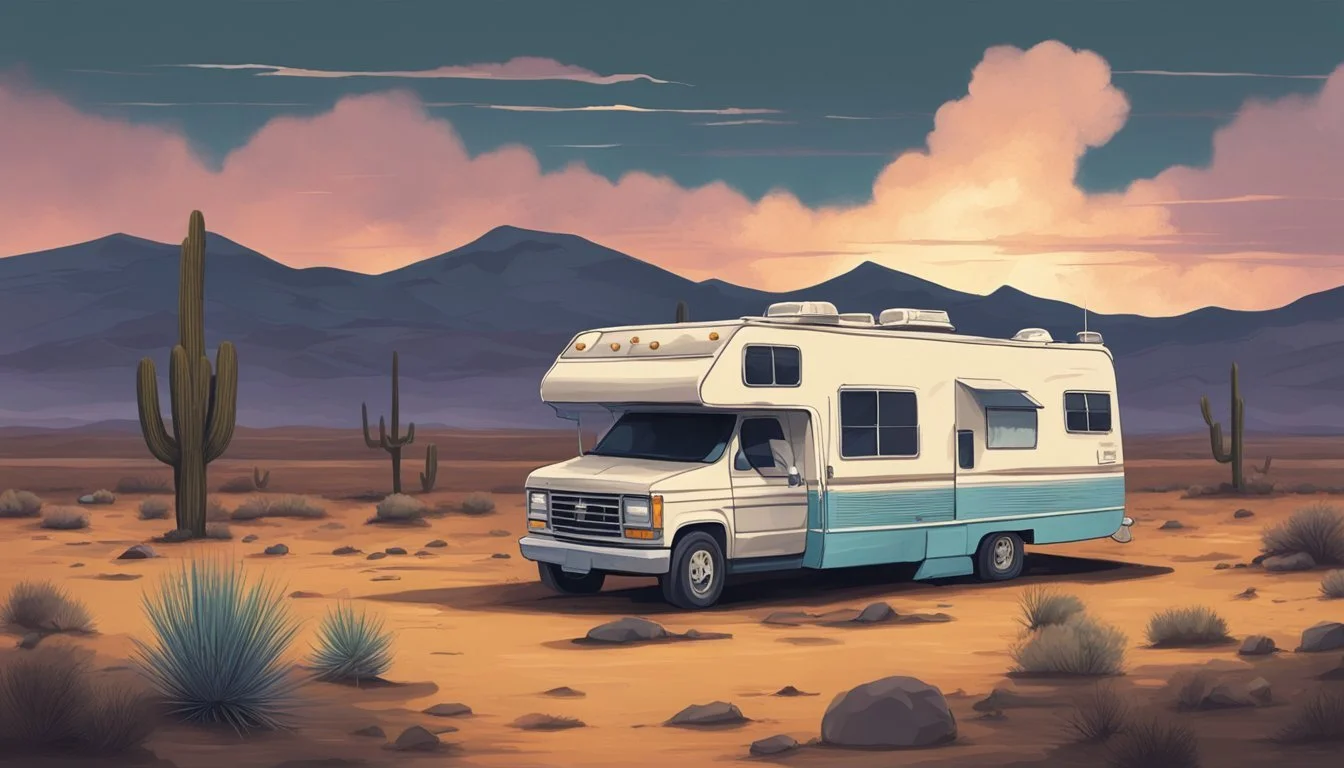Breaking Bad's Cinematography: Framing the Moral Decay
Visual Storytelling in a Criminal World
Breaking Bad's cinematography stands as a visual masterpiece, elevating the storytelling to new heights. The show's meticulous framing and composition serve as a powerful tool to convey the gradual moral decay of its characters, particularly Walter White. Through carefully crafted shots and evolving visual styles, Breaking Bad's cinematography mirrors the internal transformations of its protagonists, creating a rich tapestry that enhances the narrative and deepens viewer engagement.
The series, created by Vince Gilligan for AMC, employs a range of techniques to visually represent the ethical decline of its characters. From wide-angle shots that emphasize the vastness of the New Mexico desert to claustrophobic close-ups that capture the mounting pressure on Walter White, each frame is purposefully designed to reflect the characters' psychological states and moral dilemmas.
Time-lapse photography and unique camera angles further contribute to the show's visual language, offering a cosmic perspective on the events unfolding in Albuquerque. These techniques not only showcase the passage of time but also underscore the insignificance of individual actions in the grand scheme of things, adding layers of meaning to the narrative and reinforcing the themes of transformation and moral ambiguity that define Breaking Bad.
The Visual Language of Breaking Bad
Breaking Bad's cinematography crafts a distinct visual language that enhances the storytelling and character development. The show's aesthetic choices, symbolism, and lighting techniques work in concert to create a visually compelling narrative.
Establishing the Aesthetic Tone
Breaking Bad's visual style is rooted in the stark landscapes of New Mexico. The show's creators use wide shots to capture the vast desert expanses, emphasizing the characters' isolation and moral desolation.
Color plays a crucial role in setting the tone. The series begins with a muted palette, reflecting Walter White's mundane life. As the story progresses, vibrant hues emerge, signaling his transformation into Heisenberg.
Time-lapse photography is employed to show the passage of time and the relentless march of events, regardless of the characters' actions.
Symbolism Through Cinematography
The cinematography in Breaking Bad is rich with symbolic imagery. Camera angles often reflect power dynamics between characters, with low-angle shots portraying dominance and high-angle shots suggesting vulnerability.
Framing techniques are used to convey emotional states. Tight, claustrophobic shots emphasize tension and paranoia, while open compositions suggest freedom or isolation.
Visual motifs recur throughout the series. The iconic hazmat suits symbolize Walt's descent into the criminal underworld, while recurring images of reflections hint at the characters' dual natures.
The Role of Natural Light and Chiaroscuro
Breaking Bad masterfully utilizes natural light and chiaroscuro to enhance its visual storytelling. The harsh New Mexico sunlight often creates stark contrasts, emphasizing the show's themes of moral ambiguity.
Chiaroscuro lighting techniques are employed in interior scenes to create dramatic shadows and highlight the characters' internal conflicts. This play of light and dark mirrors the moral struggles at the heart of the series.
As the story darkens, so does the lighting. Later seasons feature more nighttime scenes and shadowy interiors, reflecting the characters' deepening involvement in the criminal world.
Character Studies in Framing
Breaking Bad's cinematography masterfully uses framing techniques to visually convey each character's moral development and complexity. The camera work reveals hidden depths and shifting allegiances through strategic shot composition and visual motifs.
Walter White's Transformation
Walter White's descent into criminality is reflected in his evolving visual presentation. Early episodes frame him as small and powerless, often dwarfed by his surroundings. As Heisenberg emerges, low-angle shots make Walt appear larger and more intimidating.
Close-ups on Walt's face become more frequent and intense, highlighting his growing ruthlessness. The camera lingers on his cold stares and calculating expressions.
Scenes in the desert showcase Walt's isolation and moral decay. Wide shots emphasize the vast, empty landscape, mirroring his internal desolation. His iconic pork pie hat casts shadowy patterns across his face, visually representing his dual nature.
Jesse Pinkman's Moral Ambiguity
Jesse's framing shifts to reflect his tumultuous journey. Initially portrayed through chaotic handheld shots, his world stabilizes as he finds purpose in cooking meth. The camera work becomes more steady and controlled.
As Jesse grapples with the consequences of his choices, he's often framed through doorways or windows. This visual metaphor highlights his feeling of being trapped between two worlds.
Close-ups on Jesse's expressive eyes convey his inner conflict and vulnerability. In moments of crisis, the camera pushes in tight on his face, immersing viewers in his emotional turmoil.
Gus Fring and the Antihero
Gus Fring's calculated nature is reflected in precise, symmetrical framing. His composed exterior is mirrored in carefully balanced shots that emphasize order and control.
The camera often captures Gus from a distance, reinforcing his enigmatic aura. When his mask slips, sudden close-ups reveal flashes of the ruthless criminal beneath the surface.
Scenes in Gus's sterile lab contrast sharply with the chaotic outside world. The pristine environment, captured in wide shots, represents his methodical approach to the drug trade.
Storytelling Through the Lens
Breaking Bad's cinematography serves as a powerful narrative tool, elevating the story beyond dialogue and action. The show's visual techniques immerse viewers in the characters' experiences and psychological states.
POV Shots and Narrative Engagement
Point-of-view shots in Breaking Bad draw audiences into characters' perspectives. These shots often appear during intense moments, such as when Walt first cooks meth in the RV.
The camera mimics Walt's frantic movements, creating a sense of urgency and disorientation. This technique is particularly effective in Season 1, as viewers experience Walt's descent into the criminal world firsthand.
POV shots also highlight characters' vulnerabilities. In Season 2, a POV shot from Jesse's perspective shows his disorientation after a drug binge, emphasizing his struggle with addiction.
Time-Lapses and Temporal Perception
Time-lapse photography in Breaking Bad conveys the passage of time and the relentless march of events. These shots often depict the vast New Mexico sky or bustling cityscapes.
In Season 3, time-lapses show the DEA's surveillance of Jesse's house, building tension as Walt and Jesse attempt to evade capture. This technique also underscores the contrast between the characters' frantic lives and the indifferent passage of time.
Time-lapses serve as visual metaphors for character transformations. As Walt's empire grows, these shots become more frequent, reflecting the accelerating pace of his moral decay.
Close-Ups and Emotional Intimacy
Close-up shots in Breaking Bad reveal characters' inner turmoil and emotional states. These intimate frames capture subtle facial expressions, allowing viewers to connect with characters on a deeper level.
In pivotal moments, close-ups intensify the emotional impact. Walt's face fills the frame as he watches Jane die, his conflicted expression revealing his moral struggle.
Close-ups also highlight physical transformations. As Walt's cancer progresses and he embraces his Heisenberg persona, these shots emphasize his changing appearance and hardening demeanor.
Cinematic Techniques and Innovations
Breaking Bad's visual style employs a range of innovative techniques to enhance storytelling and character development. These methods draw inspiration from cinematic masters while pushing boundaries in television cinematography.
Michael Slovis's Contributions
Michael Slovis, the show's cinematographer from season 2 onwards, brought a distinct visual flair to Breaking Bad. He introduced a more cinematic look, utilizing wide-angle lenses and extreme close-ups to create visual tension.
Slovis emphasized color theory, using warm yellows and oranges for scenes in New Mexico's desert, contrasting with cool blues and greens in lab settings. This color palette helped establish mood and location.
He also pioneered the use of unique camera angles, including POV shots from inanimate objects. These techniques added depth to scenes and provided fresh perspectives on characters' actions.
The Influence of Sergio Leone
Breaking Bad's visual style draws heavily from Sergio Leone's spaghetti westerns. Wide, sweeping shots of the New Mexican desert echo Leone's iconic landscapes.
The show utilizes extreme close-ups reminiscent of Leone's work, particularly during tense confrontations. These shots heighten emotional intensity and reveal subtle character reactions.
Leone's influence is also evident in the show's use of negative space and careful framing. Characters are often positioned off-center or at the edges of the frame, creating visual unease.
Handheld Camerawork and Claustrophobia
Handheld camera techniques play a crucial role in creating tension and intimacy in Breaking Bad. This approach is particularly effective in scenes of violence or emotional turmoil.
In confined spaces like the RV or basements, handheld shots enhance the sense of claustrophobia. The camera movements mimic characters' anxiety, immersing viewers in their experiences.
This technique contrasts sharply with the show's wide, static shots of landscapes. The juxtaposition highlights the characters' inner turmoil against the vast, indifferent backdrop of the desert.
Lighting as a Storyteller
Lighting plays a crucial role in Breaking Bad, enhancing the narrative and reflecting characters' inner states. It creates atmosphere, emphasizes emotions, and subtly guides viewers' perceptions throughout the series.
Contrasting Darkness and Light
Breaking Bad masterfully uses light and shadow to convey meaning. Scenes in Walter White's home often start bright but grow darker as his moral descent progresses. The meth lab's harsh fluorescent lighting contrasts sharply with the warm glow of family scenes, highlighting Walt's dual life.
Backlighting creates striking silhouettes, particularly in pivotal moments. This technique emphasizes characters' isolation and internal struggles. The New Mexico sun casts long shadows, adding visual depth and a sense of impending doom to outdoor scenes.
Directors use low-key lighting to build tension in clandestine meetings and dangerous encounters. This creates a noir-like atmosphere, reinforcing the show's themes of moral ambiguity and hidden motives.
The Psychology of Color in 'Breaking Bad'
Color symbolism in Breaking Bad's lighting design adds layers of meaning to each scene. The show's palette shifts as the story unfolds, reflecting characters' changing motivations and circumstances.
Blue light often represents purity or legitimacy, seen in Hank's DEA office and early scenes with Walt's family. As Walt embraces his criminal persona, warmer yellows and oranges dominate, symbolizing danger and moral corruption.
Green lighting, associated with money and greed, becomes more prevalent as characters become entangled in the drug trade. Red, signifying violence and blood, appears in moments of extreme danger or moral transgression.
The lighting team uses color mixing to create unsettling effects. Scenes with conflicting motivations often feature clashing color temperatures, visually representing characters' internal turmoil.
Cultural Impact and Legacy
Breaking Bad's influence extends far beyond its narrative and visual artistry. The show transformed television and permeated popular culture in profound ways.
Breaking Bad as a Cultural Phenomenon
Breaking Bad's ascent to cultural phenomenon status was swift and enduring. The show's popularity skyrocketed during its later seasons, particularly Season 4 and Season 5. Catchphrases like "I am the one who knocks" and "Yeah, science!" became part of everyday vocabulary. Walter White's transformation into Heisenberg inspired countless Halloween costumes and merchandise.
The show's themes of moral decay and the consequences of choices resonated deeply with audiences. Breaking Bad sparked discussions about ethics, the healthcare system, and the nature of evil. Its exploration of the American Dream's dark side struck a chord with viewers grappling with economic uncertainties.
Fan theories and analyses flourished online, creating a dedicated community of viewers who dissected each episode. This engagement helped cement Breaking Bad's place in the cultural zeitgeist.
Influence on Television Dramas
Breaking Bad raised the bar for television dramas, inspiring a new wave of complex, character-driven narratives. Its success proved that audiences were hungry for morally ambiguous protagonists and intricate storytelling.
The show's visual style influenced countless productions. Its use of unique camera angles, time-lapse photography, and color symbolism became widely emulated. Breaking Bad's approach to pacing and tension-building set new standards for dramatic television.
Many subsequent dramas adopted Breaking Bad's model of a limited series with a clear narrative arc. This shift away from open-ended storytelling allowed for tighter, more focused narratives. The show's critical and commercial success also emboldened networks and streaming services to take more risks with unconventional concepts.
'Better Call Saul' and 'El Camino': Extensions of the Legacy
The Breaking Bad universe expanded with two successful spin-offs: Better Call Saul and El Camino. Better Call Saul, focusing on the origins of lawyer Saul Goodman, matched its predecessor's critical acclaim. The show's success demonstrated the depth and richness of the Breaking Bad world.
El Camino, a feature-length film, provided closure to Jesse Pinkman's story. Its release on Netflix showcased the enduring appeal of Breaking Bad's characters years after the original series ended.
These spin-offs kept the Breaking Bad legacy alive, introducing new viewers to the original series. They also allowed creators to further explore the moral complexities and character development that made Breaking Bad so compelling.





